Introduction
Polenta is a timeless Italian dish that has earned a place in kitchens worldwide for its versatility and comforting texture. But how do you achieve that perfect, restaurant-quality polenta at home? Whether you prefer it creamy, grilled, or baked, this guide will walk you through everything you need to know to make polenta that rivals the finest Italian trattorias. Let’s uncover the secrets!
What Is Polenta? A Quick Introduction
The Origin of Polenta and Its Place in Italian Cuisine
Polenta has deep roots in Italian cooking. It started as a humble peasant dish and evolved into a staple in Italian households. Today, it’s served in both simple family meals and gourmet restaurants. Its versatility makes it a key part of Italian culinary culture.
Types of Polenta: Creamy, Firm, and Grilled
Polenta comes in different forms to suit various dishes. There is creamy polenta pairs well with rich sauces and stews. On the other hand, there is firm polenta which is perfect for slicing and layering in recipes. Along with these, there is grilled polenta that adds a smoky flavor and works as a side dish or base for toppings.
The Key Ingredient: Choosing the Right Cornmeal
The quality of cornmeal determines the quality of your polenta. For the best results, choose stone-ground or medium-grind cornmeal. These types provide the ideal texture and flavor. Try to avoid instant cornmeal, as it does`t provide that authentic taste of traditional polenta that you would like to savour when preparing this dish.
Nutritional Benefits of Polenta
Polenta is a naturally gluten-free dish, making it a great option for those with dietary restrictions. furthermore, It’s also low in fat and rich with complex carbohydrates, which provide long-lasting energy. But when you add cheese or butter remember that you are enhancing flavor, ant at the same time you increasing calories you put in your body. So, make a mindful choice when preparing this dish.
Popular Variations and Uses Worldwide
Polenta isn’t just for Italian recipes. with time it became international with limiteless variations. In France, people use it as a base for savory dishes. In the U.S., it became their favorite for crispy fries. Around the world, chefs experiment with toppings like mushrooms, roasted vegetables, and even sweet flavors like honey or fruit.
By understanding the basics of polenta, you’ll appreciate its versatility and flavor. It’s more than just a dish—it’s a canvas for culinary creativity.
Essential Ingredients for Perfect Polenta
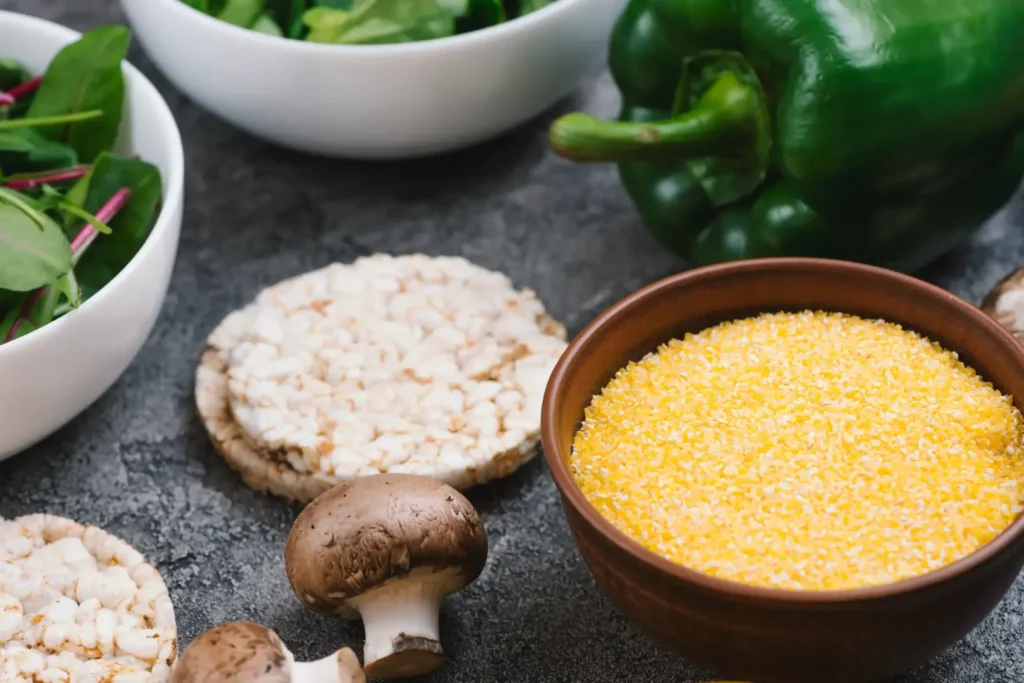
The Best Type of Cornmeal for Restaurant-Quality Results
The type of cornmeal you choose matters. For authentic polenta, it is recommended to use stone-ground or medium-grind cornmeal. These two combine rich flavor with a creamy texture, which is critical for making perfect polenta. Avoid instant or fine cornmeal as they may compromise the dish’s quality.
Liquid Options: Water, Stock, or Milk—What Works Best?
The liquid you use can change the flavor of your polenta. Water creates a neutral base. Stock adds depth and enhances the savory taste. Milk makes the polenta creamy and smooth. Choose the liquid based on the dish you’re serving.
Enhancing Flavor with Butter, Olive Oil, or Cream
Add fats to elevate your polenta. Butter gives a rich and indulgent taste. Olive oil, adding to its health benefits, it provides you with subtle and fruity flavor. The cream creates a velvety finish. Choose the one that matches your preference and the recipe.
Using Parmesan Cheese or Other Cheeses for Richness
Cheese is a key ingredient for creamy and flavorful polenta. Among all variety of cheeses, parmesan is a classic choice that perfectly adds the nutty taste you look for in polenta. You can also use Pecorino, Gouda, or Mozzarella for variety. Stir in grated cheese for a smooth and luscious texture.
Optional Ingredients: Herbs, Garlic, or Truffle Oil
Herbs like rosemary, thyme, or basil add fresh aromas. Garlic brings a bold and savory kick. Add a drizzle truffle oil before serving if you are looking for thst touch of luxury. These extras enhance the flavor and make your dish more exciting.
With these simple ingredients and tips, your polenta will turn out to be of restaurant quality every time. Try it and enjoy a perfect polenta of your own making!
Step-by-Step Guide to Cooking Creamy Polenta
The Importance of the Liquid-to-Cornmeal Ratio
Getting the right liquid-to-cornmeal ratio is key to creamy polenta. The perfect ration is 4 cups of liquid for every 1 cup of cornmeal. This ratio gurantaees a smooth and soft texture. For liquids, feel free to use water, stock, or milk and try to enjoy different tastes accordinly.
How to Avoid Lumps During the Cooking Process
Lumps form when cornmeal clumps together which is comon when you cook corn. To prevent this, whisk the cornmeal into boiling liquid slowly. Keep stirring constantly as it cooks. A consistent motion helps distribute the cornmeal evenly and keeps the mixture smooth.
Tips for Stirring and Simmering to Achieve the Perfect Texture
Stirring is essential for creamy polenta. Stir every few minutes to prevent sticking and clumping. Let the mixture simmer over low heat. You want your cornmeal to fully absorb the liquid. This process creates a silky and rich texture.
The Role of Resting Time for the Best Consistency
Once the polenta is cooked, let it rest for 5 to 10 minutes. Resting helps the flavors settle and thickens the texture. Cover the pot to keep the heat in while it rests. This step makes a noticeable difference in the final dish. Never serve this dish directly after it is cooked. This will prevent you from having your perfect polenta the way it meant to be.
Common Mistakes and How to Fix Them
Rushing the cooking process is a common mistake. Take your time to cook polenta low and slow. If it’s too thick, add more liquid and stir well. For lumps, use a whisk or immersion blender to smooth them out.
Following these steps will help you create creamy polenta easily. If you mess up your first dish, don`t give up; just try it again and again. Practice always makes perfect. You will master this simple yet delicious dish very soon!
Tips for Achieving Restaurant-Quality Polenta
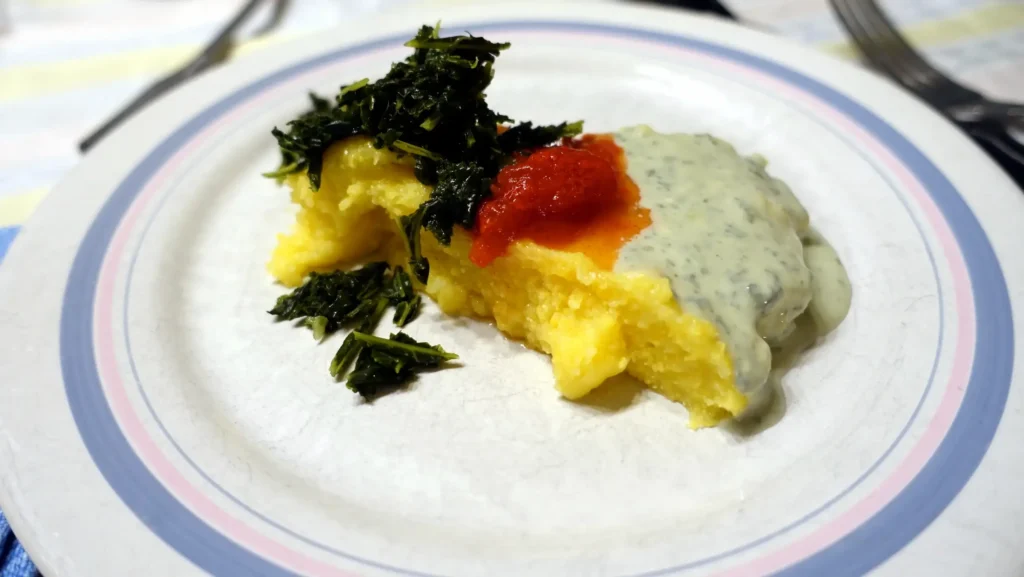
Why Low and Slow Cooking Makes a Difference
Cooking polenta low and slow is essential for the best results. It allows the cornmeal to absorb liquid fully and develop a creamy texture. Rushing the process can lead to lumps or uneven cooking. Be patient, and stir consistently for a smooth finish.
Balancing Flavors with Seasoning and Finishing Touches
Seasoning is key to great polenta. Add salt early to infuse flavor into the dish. Finish with freshly cracked pepper, herbs, or a bit of olive oil for that gourmet touch you are looking for. Don’t overdo it—balance is the secret to restaurant-quality results.
How to Get a Silky Texture with the Right Stirring Technique
Stirring frequently is critical to avoid lumps and achieve a silky consistency. Use a wooden spoon or whisk to keep the mixture smooth. Stir gently but consistently to ensure even cooking. This technique creates the velvety texture you’re aiming for when deciding to cook this amazing polenta recipe.
Presentation Tips: How Plating Elevates the Dish
Plating polenta creatively can make it look like a professional dish. Serve creamy polenta in a shallow bowl with toppings arranged neatly. For firm polenta, slice it evenly and layer it on the plate. Garnish with herbs or cheese for a polished look.
Pairing Ideas: Meats, Vegetables, and Sauces That Complement Polenta
Polenta is versatile and pairs well with many dishes. Serve it with braised meats like beef stew or lamb shank. Roasted vegetables and mushrooms are great for vegetarian options. Sauces like tomato-based ragù or creamy mushroom sauce complete the dish beautifully.
By following these tips, you can elevate your polenta to restaurant standards. Simple techniques and thoughtful pairings make all the difference!
Creative Ways to Serve and Enjoy Polenta
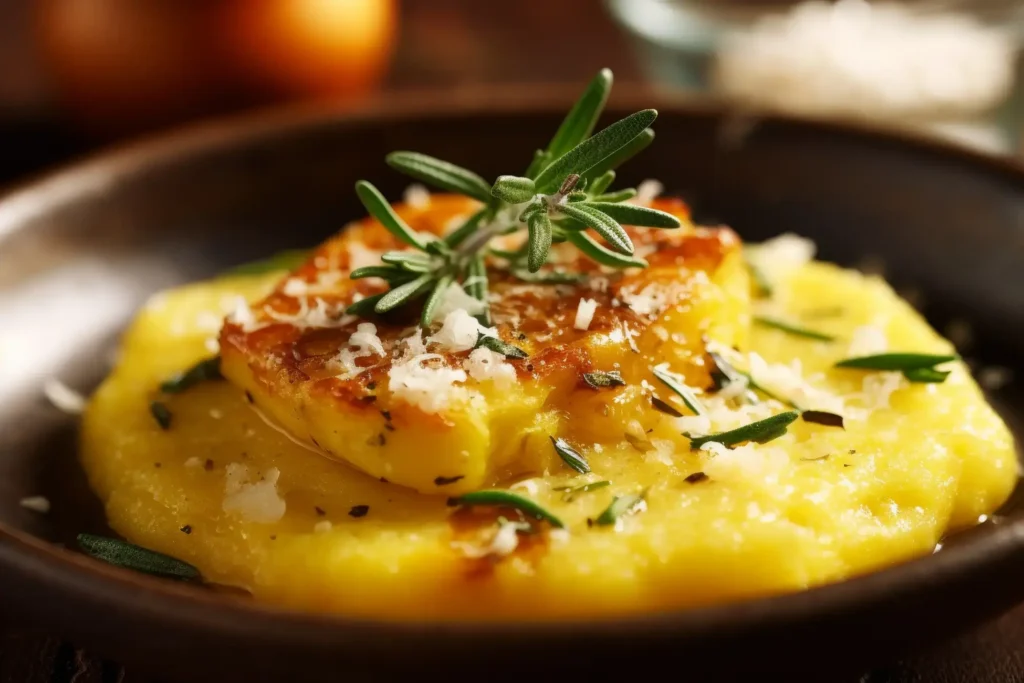
Creamy Polenta as a Base for Stews or Braised Dishes
Creamy polenta is perfect for hearty meals. Use it as a base for stews, braised beef, or slow-cooked lamb. The smooth texture absorbs the rich flavors of the sauces. This combination creates a comforting and satisfying dish.
Grilled or Baked Polenta Slices for Appetizers or Sides
Firm polenta can be cut into slices and cooked on the grill or in the oven. Serve it as a crispy appetizer or a side dish. Top the slices with roasted vegetables, melted cheese, or marinara sauce. Grilled polenta adds a smoky flavor and a unique twist to your meal.
Polenta Fries: A Crispy and Fun Twist
Polenta fries are a creative alternative to regular fries. Cut firm polenta into sticks, bake or fry until crispy, and season with herbs. Pair them with flavorful dips such as aioli or zesty ketchup. They’re perfect for snacking or as a party appetizer.
Sweet Polenta: An Unexpected Dessert Option
Polenta isn’t just for savory dishes. Turn it into a dessert by sweetening it with sugar or honey. Add vanilla, cinnamon, or citrus zest for flavor. Serve with fresh fruit, jam, or whipped cream for a delicious and unique treat.
Reheating and Repurposing Leftovers Creatively
Don’t waste leftover polenta. Reheat it with a splash of milk for a creamy texture. Slice firm polenta and pan-fry it for a quick snack. You can even crumble it and use it as a topping for soups or salads.
Polenta’s versatility makes it an exciting addition to any menu. Experiment with these ideas to enjoy them in new and delicious ways!
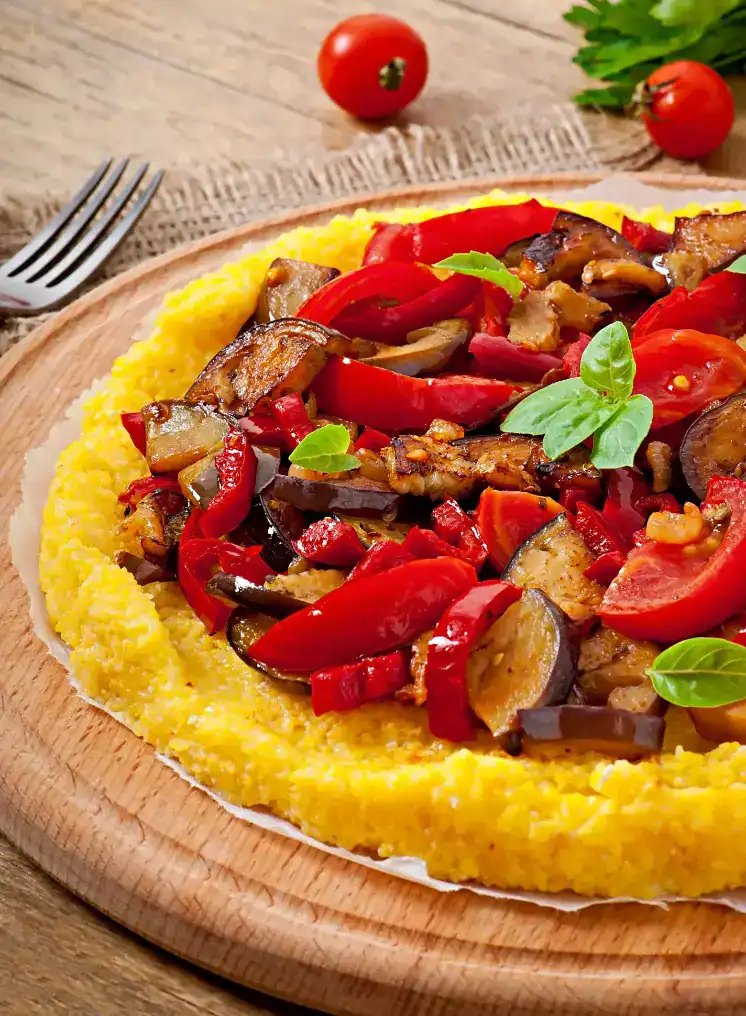
Perfect Polenta Recipe
Ingredients
Method
- Boil Liquid: Bring 4 cups of water or stock and 1 teaspoon of salt to a boil in a medium saucepan.
- Add Polenta: Gradually whisk in 1 cup of polenta to avoid lumps.
- Simmer: Reduce heat to low and cook, stirring frequently, for 30-40 minutes until thick and creamy.
- Finish: Stir in 2 tablespoons of butter and 1/2 cup of Parmesan (if using).
- Serve: Serve hot as a side or let cool and set for slicing, grilling, or baking.
FAQs About Making Polenta
What Type of Cornmeal Is Best for Polenta?
For the best polenta, use stone-ground or medium-grind cornmeal. Stone-ground cornmeal retains more flavor and texture, making it ideal for authentic polenta. Avoid fine or instant cornmeal, as it doesn’t create the same creamy consistency.
Can I Make Polenta Ahead of Time?
Yes, you can make polenta in advance. Save it appropriately in the fridge. To reheat creamy polenta, add a splash of water or milk and stir until smooth. For firm polenta, slice and grill or pan-fry it before serving.
How Do I Fix Lumpy Polenta?
Lumpy polenta happens when cornmeal isn’t whisked properly. To fix it, use a whisk to break up the lumps while it’s still hot. For stubborn lumps, blend the polenta with an immersion blender until smooth. Consistent stirring prevents this problem.
Is Polenta Gluten-Free?
Polenta is inherently gluten-free since it is made from corn. However, check the packaging for cross-contamination warnings if you have celiac disease. Stick to certified gluten-free cornmeal for safety.
What Are the Best Toppings for Polenta?
Polenta pairs well with a variety of toppings. For savory options, try roasted vegetables, mushrooms, or slow-cooked meats. Add honey, fresh fruit, or a dusting of cinnamon for sweet polenta. Toppings enhance the flavor and make the dish unique.
These answers should help you make the perfect polenta every time. You’ll enjoy restaurant-quality results in your kitchen with the right ingredients and tips!
Conclusion
With the right ingredients, techniques, and a little patience, you can create a polenta dish that feels like it was prepared in an upscale Italian restaurant. Whether served creamy, grilled, or baked, polenta is the ultimate canvas for your culinary creativity. Experiment with toppings, pairings, and variations to make it your own. Now it’s time to take these tips and secrets into your kitchen and master the art of polenta!
For more recipes, try our:

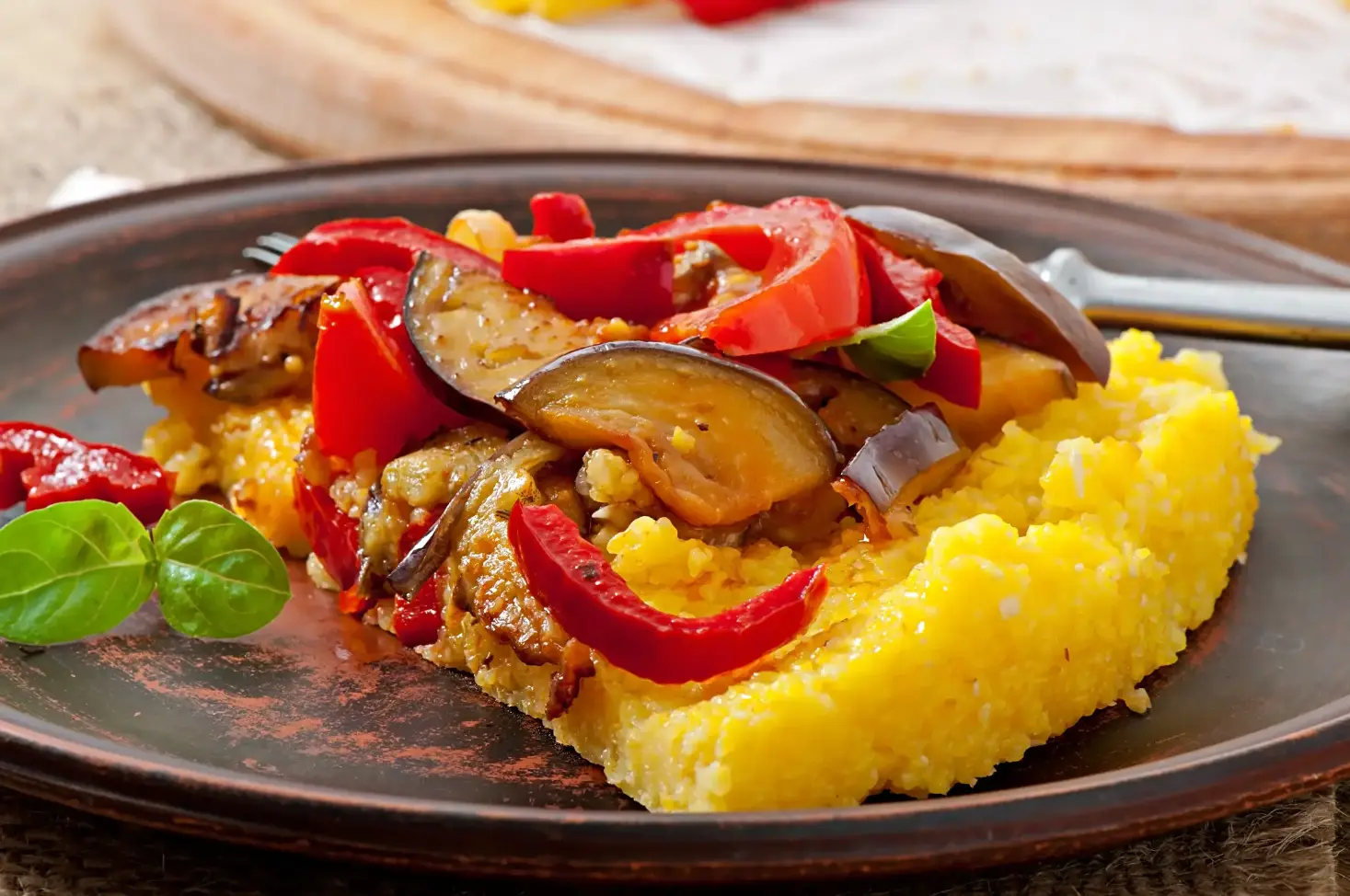
7 thoughts on “How to Make the Perfect Polenta: Secrets to a Restaurant-Quality Dish”